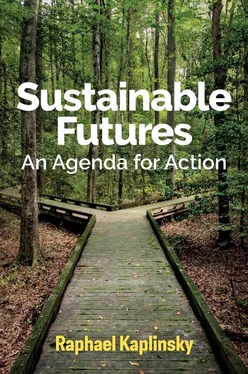A second and related consequence of this change in tax incentives was a process of widespread and systematic ‘looting’ of company coffers by senior executives and shareholders. Not only did senior management gain from their appreciating share options but, instead of using profits to invest in the future, profits were distributed to shareholders, which of course included the very same executives who made the decisions on what to do with profits. Mariana Mazzucato refers to this as a transition from ‘value addition’ to ‘value extraction’. 6
The outcome of these developments can be seen in the changing face of stock markets. Stock markets are in theory supposed to provide the finance for new productive investments. Companies which require funds to invest in expansion and product development can raise resources by issuing shares to investors. During the 1950s and 1960s, the stock markets in the US had served this function. They provided substantial investment finance for the non-financial corporate sector, averaging more than 0.5 per cent of GDP. But the changes in tax legislation introduced in the early 1980s by Ronald Reagan changed the direction of financial flows. The flow of funds shifted from investors providing funds to the corporate sector via the stock market, to the corporate sector shifting funds to shareholders, again via the stock market. In the decade before, during and after the 2008 Financial Crisis, the accumulated flow of funds from the corporate sector to the stock markets was an astonishing $4.46tn, equivalent to 2.7 per cent of total US GDP over the period. 7
The neo-liberal tax reforms introduced by the Trump Administration in 2017 (the Tax Cuts and Jobs Act) provided a further bonanza to shareholders. Sixteen US corporations which had held financial assets of more than $1 trillion outside the US had been waiting for the day in which they could repatriate these funds to the US at reduced tax rates. They argued that punitively high corporate taxes of 35 per cent inhibited them from returning global profits to invest in the US. The value of these external assets for the five major companies was $269bn for Apple, $143bn for Microsoft, $107bn for Alphabet, $76bn for Cisco and $71bn for Oracle. Following intense lobbying from these major corporations, the 2017 tax reforms reduced the tax paid on these repatriated funds from 35 per cent to 16.5 per cent. In the first nine months of 2018, the five largest tech firms utilized only $19.3bn of this windfall for capital investment. They distributed the bulk ($115bn) to shareholders in the form of share buybacks. So much for tax reduction inducing investment and growth!
The consequences of financialization are not limited to undermining long-term investments in the corporate sector and the looting of corporate funds. It has also led to the development of a component of the financial sector which is detached from the economically useful function of transferring money from savers to productive investors. Fuelled in part by the liquidity injected into economies by QE programmes, massive quantities of money have been directed into arbitrage, that is buying and selling to gain from price differentials.
This was one of the factors driving up the prices of raw materials during the commodities boom between 2003 and 2014. Growing demand for raw materials from China and other countries led to an increase in their price. Anticipating this growing demand for commodities, financial speculators bought primary commodities in the expectation that their prices would continue to rise. In so doing, they accentuated the growth in commodity prices. 8Financial speculation for arbitrage was not limited to physical commodities. For example, investors took advantage of the low interest rates in their home economies to speculate on changing currency rates. Large sums of money were borrowed and transferred to bank accounts in other countries which had very slightly higher interest rates. The differential in interest rates was often minute and short-lived, but, since they applied to very large money transfers, profits were substantial.
As we saw above in the discussion of Quantitative Easing, another avenue for financial speculation was the housing market, particularly in the US. During the 1990s, and especially after the turn of the millennium, many poor and middle-income householders were aggressively sold mortgages to buy their own homes. The attraction to borrowers was that house prices were growing at 10 per cent per annum. Moreover, they were offered enticing terms. These loans often began with near-zero interest rates, which then escalated after a few years to unaffordable levels. Irresponsible lenders paid little attention to the valuation of the properties or to the capacity of borrowers to meet their monthly repayments. They were only interested in the commissions they earned on arranging these loans. Risky loans were bundled together with more secure mortgages in Collateralized Debt Obligations (CDOs). These CDOs had very low levels of transparency and were sold and resold as if they were secure assets. Each round of sale, of course, earned commissions for the financiers involved in the transactions. But, ultimately, the pack of cards in these schemes collapsed, triggering the 2008 Financial Crisis. Mortgage defaults led to a sharp fall in house prices and widespread personal bankruptcy, with devastating welfare impacts. As I will show in the following chapter, the numbers of homeless families in the US ballooned, as did the incidence of poverty and ill health. After decades of improvement, life-expectancy began to fall.
So, what is the relevance of the post-1980s neo-liberal policy regime to the rise and fall of the Mass Production paradigm from the end of World War 2 to the present day? As we have seen above, these policies exacerbated the underlying decline in rates of productivity growth, investment and economic growth. Changes in the tax regime and the inability to direct QE money into productive investments fuelled a climate of short-termism and a reluctance to invest in innovation for the long term. The combination of free-trade policies and the retreat from industrial policies destroyed large swathes of manufacturing and led to the growth of depressed rust-belt societies. It also resulted in unsustainable unevenness in global trade, with the US in particular sinking into ever deeper international trade deficits.
2.4 Can the Mass Production Paradigm Be Reinvigorated?
So much for the past seventy years. But what are the prospects for the Mass Production growth trajectory being sustainable in the future? Leaving aside the challenge of recovering from the economic damage of Covid-19, can Mass Production’s growth trajectory be reinvigorated? In what follows in the concluding sections of this chapter, I discuss a number of structural features intrinsic to the Mass Production paradigm which undermine the prospects for sustainable economic growth.
The Great Recession of 2007–2018 – the sticking plaster wears off
The twentieth century ended with a collapse in stock markets, particularly in the US, and particularly in the share values of the high-tech sector. More than 100 million people globally were plunged below the $1-per-day absolute poverty line as a consequence of this burst high-tech stock bubble. This economic crisis was relatively short lived. But it was succeeded by a much more severe and persistent economic crash which began to unfold in late 2007. As we have seen, the trigger for this severe economic disruption was a crisis in the US housing market.
The domino effect of this real estate crash spread rapidly through the US economy. In short order, 176 banks failed in 2009. Unemployment doubled from 4.9% in 2007 to more than 10% in 2009. The Dow Jones stock exchange index fell 54% in 17 months. Two of America’s largest automobile companies – Ford and Chrysler – had to be rescued with government funding. It is estimated that the total level of support provided by the Federal Government to the financial sector was more than $4tn. Although much of this was repaid, this nevertheless led to a long-term burden on taxpayers of more than $1.2tn.
Читать дальше












